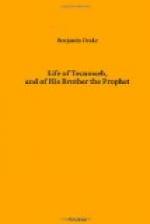In the course of the summer of this year, 1795, he commenced raising a party of his own, and began to style himself a chief. He did not attend the treaty of Greenville, held by general Wayne, on the 3d of August, 1795, with the hostile Indians, but after its conclusion, Blue Jacket paid him a visit on Deer creek, and communicated to him the terms on which peace had been concluded.
Tecumseh remained at this place until the spring of 1796, when he removed with his party to the Great Miami, near to Piqua, where they raised a crop of corn. In the autumn he again changed his place of residence, and went over to the head branches of White Water, west of the Miami, where he and his party spent the winter; and in the spring and summer of 1797, raised another crop of corn.
In the year 1798, the Delawares, then residing in part, on White river, Indiana, invited Tecumseh and his followers, to remove to that neighborhood. Having accepted this invitation, and made the removal, he continued his head quarters in the vicinity of that nation for several years, occupied in the ordinary pursuits of the hunter-life—gradually extending his influence among the Indians, and adding to the number of his party.
In 1799, there was a council held about six miles north of the place where Urbana now stands, between the Indians and some of the principal settlers on Mad River, for the adjustment of difficulties which had grown up between these parties. Tecumseh, with other Shawanoe chiefs, attended this council. He appears to have been the most conspicuous orator of the conference, and made a speech on the occasion, which was much admired for its force and eloquence. The interpreter, Dechouset, said that he found it very difficult to translate the lofty flights of Tecumseh, although he was as well acquainted with the Shawanoe language, as with the French, which was his mother tongue.[A]
[Footnote A: James Galloway, of Xenia.]
We next hear of Tecumseh, under circumstances which show the confidence reposed in him by the white settlers on the frontier.
In the month of April, 1803, Thomas Herrod, living sixteen miles north-west of Chillicothe, was shot, tomahawked, and scalped, near his own house. The Indians were suspected of having committed this deed; a wanton and cruel retaliation was made upon one of them, (guiltless no doubt of that particular crime,) and the settlement in the Scioto valley and north-west of it, was thrown into a state of much excitement. The Indians fled in one direction and the whites in another. For the purpose of ascertaining the facts in the case, and preventing further hostilities, several patriotic citizens of Chillicothe mounted their horses, and rode into the Indian country, where they found Tecumseh and a body of Indians. They disavowed all knowledge of the murder of Herrod, and stated, explicitly, that they were peaceably inclined, and disposed to adhere to the treaty of Greenville. Tecumseh finally agreed




